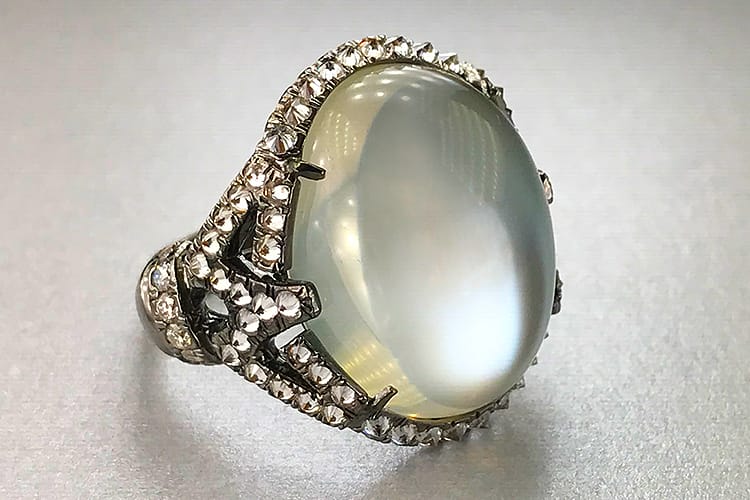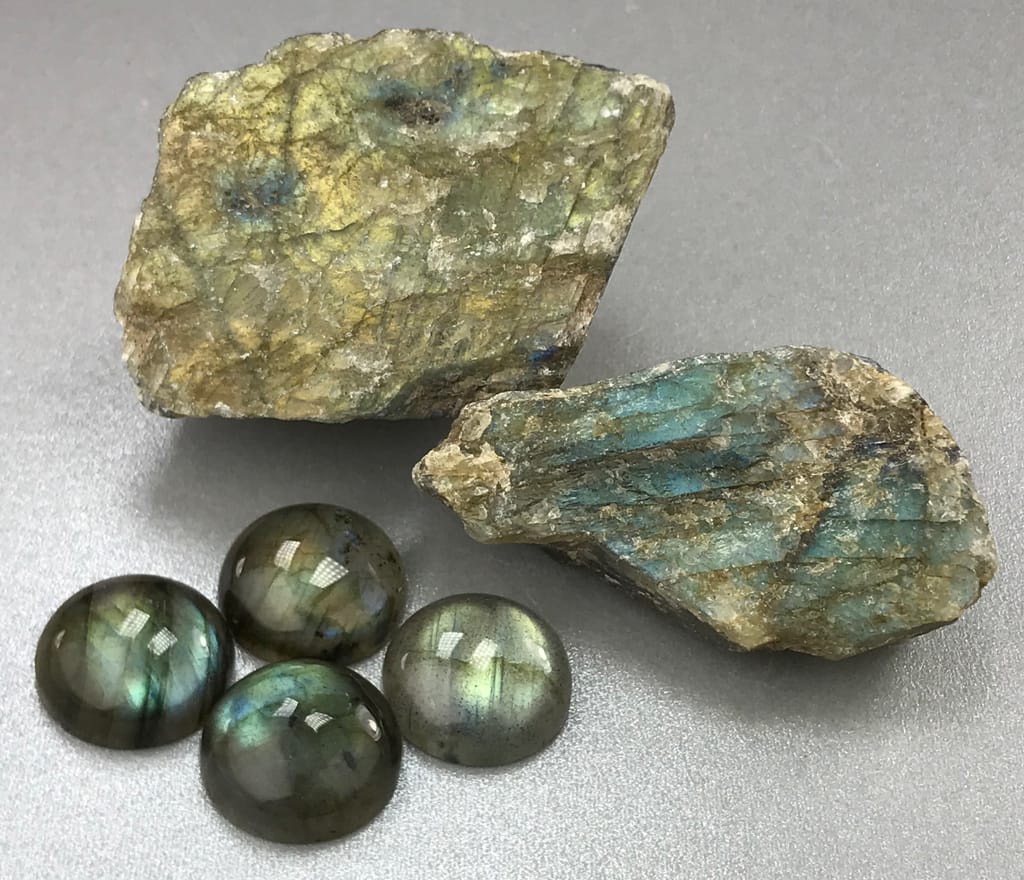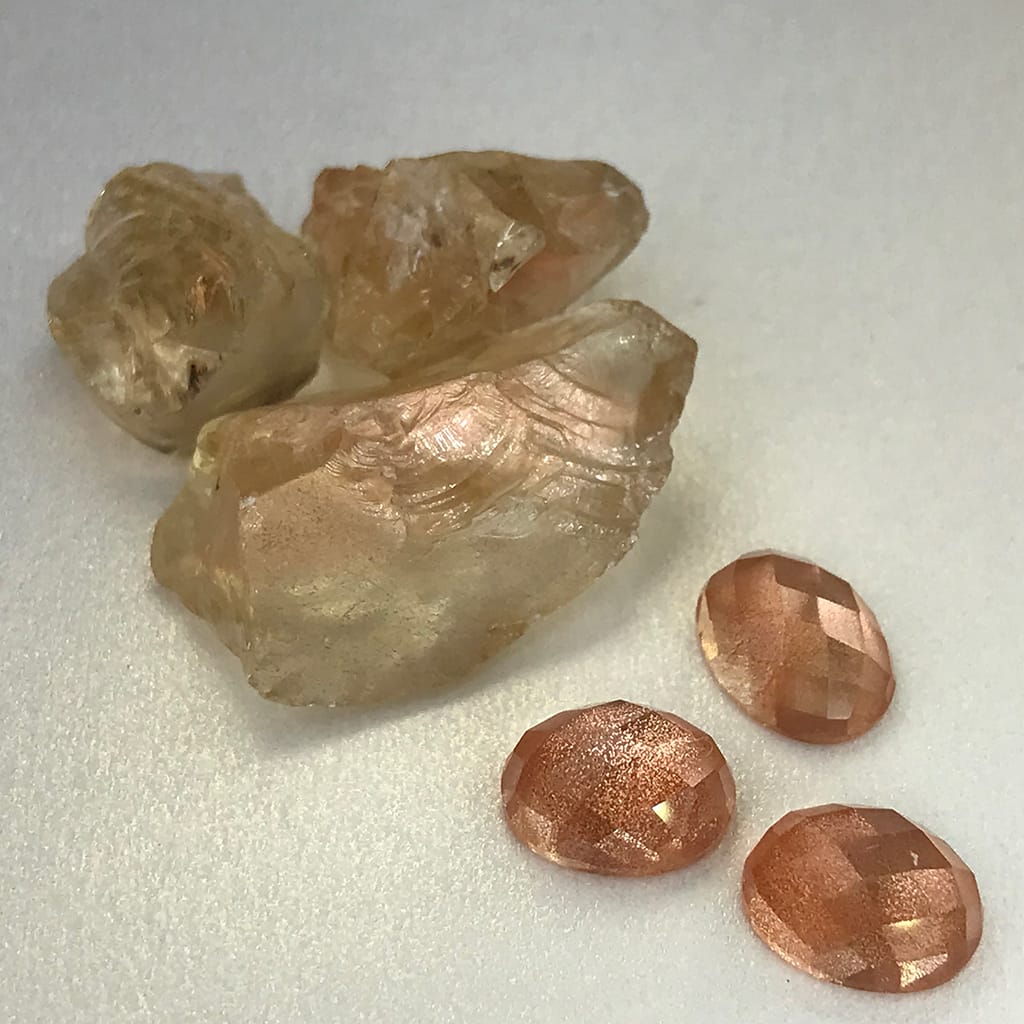Guide to Moonstone & Labradorite

Moonstone ring
History, Lore and Appreciation
Feldspar is an extremely diverse group of minerals that includes several species and varieties. Some varieties of feldspar possess unique optical phenomena. Feldspar is a common rock-forming mineral that is found on every continent. (It is estimated that feldspar makes up well over half of the earth’s crust). However, feldspar also has gem varieties that have been sought after and revered for centuries. In India, for example, moonstone (a variety of adularescent orthoclase feldspar, also referred to as adularia) has long been thought to be sacred. George Frederick Kunz, a famous gemologist and consultant to Tiffany & Co. in the late 1800s, notes in his book, The Curious Lore of Precious Stones, that “As a gift for lovers the moonstone takes high rank, for it is believed to arouse the tender passion.”
Under direct (and sometimes subdued) lighting conditions, moonstone exhibits adularescence, which is described as a “billowy” light effect observed along the gems’ surface. In moonstone with a white body color, “billowy blue” color may be seen. In other moonstones, asterism (4 rayed star), or cat’s eye phenomena can sometimes be observed. Moonstone may have orangey, brownish, grayish or greenish body color.
Not to be outdone in moonstone’s celestial designation, another feldspar variety is called plagioclase sunstone. This gem often exhibits warm red to brown and yellow body colors, an allusion to the name. Its phenomenal nature, however, is equally captivating. When interacting with light, similarly oriented, minuscule inclusions of copper or hematite platelets exhibit glittering, spangled reflections, shimmering through different depths within the gem. This phenomenon is known in the trade as aventurescence.
Labradorite, named after the first place it was discovered – the Labrador Peninsula in Canada, is another plagioclase feldspar that has a phenomenal effect. In certain light conditions, a broad, multicolored sheen appears to float along the gem’s surface, particularly visible as the gem, or the light source, is moved. This iridescent effect is called labradorescence. In recent years, andesine – a rare, albite-rich plagioclase feldspar has gained recognition. It began entering the market in surprising quantities in 2002. The material has been found to come from at least two known localities: Inner Mongolia and Tibet.
Microcline feldspar has one gem variety called amazonite, which is bluish green to green in color, and may be semi-translucent to opaque. Though named after the Amazon, it has not been found there as a commercial source, but is found in other states in Brazil as well as in North America, Africa and Russia. The beauty and intrigue of amazonite is revealed under direct lighting, when a fibrous interlacing between green and white streaks can clearly be seen along the gem’s surface. On rare occasions, the gemstone may also have a directional glittery effect, or sheen, under direct lighting, also caused by inclusions.
Gem feldspar occurs in non-phenomenal, transparent varieties as well, particularly in plagioclase, and orthoclase species.
In this case, the body color is generally yellow – but greenish yellow and colorless varieties occur as well. The color of feldspar has much to do with its chemical makeup, trace elements and inclusions.

Labradorite

Sunstone
Birthstones and Anniversaries
Moonstone is the birthstone for June, together with pearl and alexandrite.
Description and Properties
Microcline feldspar (amazonite) forms in the triclinic crystal system; orthoclase feldspar (most moonstones and transparent varieties) in the monoclinic crystal system; plagioclase feldspars (oligoclase, labradorite and sunstones and transparent varieties) in the triclinic crystal system. For specific properties of each species or variety, see below.
Treatments
Treatments in feldspar are not generally common, though wax impregnation of tiny fissures that reach the surface of some amazonite has been reported as well as some impregnation in moonstone. This gives the gem a more uniform look. However, such treatment is not permanent and can be affected by heat and pressure. It has also been reported that some white microcline varieties may be irradiated to achieve deep blue-greenish colors associated with amazonite. In some instances, moonstone and transparent labradorite may be backed with a black coating to better exhibit their phenomenal characteristics. In loose gems, this treatment is easily discernible. Some pale andesine is treated by a complex diffusion process to achieve rich red and yellow colors similar to those found in sunstone.
Collector Quality
Feldspars that exhibit double phenomena, such as adularescence and cat’s eye, are collector’s gems because of their rarity. Large gems and richness of color also make them collectible. Although feldspar has perfect cleavage (can separate along planes of atomic growth in the crystal), and can be damaged during the fashioning process, they are sometimes carved.
Cutting, Care and Cleaning
Feldspar, when properly cared for, is durable enough to wear in jewelry, despite being somewhat brittle at times. Cutters, who properly understand the hardness and toughness of feldspar, often cut them as cabochons, which (unlike faceted gems) are less subject to abrasion. Additionally, cabochons are more likely to exhibit the phenomenal aspects of these gems. Some lapidary artists choose to carve these gems. Feldspar is somewhat delicate and care must be taken in setting.
Feldspar should never be placed in an ultrasonic cleaner. A clean, water dampened cloth, containing no soap or other cleaning agent, is the best way to clean this gem.
Microcline
Chemical Formula: KAlSi3O8
Colors: Amazonite is light green to greenish blue, white and rarely light orange or pink.
Refractive Index: 1.522 to 1.530 (±0.004)
Birefringence: 0.008
Specific Gravity: 2.56 (±0.02)
Cause(s) of color: Amazonite – color centers involving lead and water.
Mohs Hardness: 6 to 6.5
Localities: Amazonite is found in the Unites States, mainly in Colorado, but also in Madagascar, Myanmar (Burma), Brazil, Germany and Russia.
Orthoclase
Chemical Formula: KAlSi3O8
Colors: (Moonstone) is colorless to white, green, yellow brown or grey and rarely black
Refractive Index: 1.518 to 1.526 (+0.010) Birefringence: 0.05 to 0.008
Specific Gravity: 2.58 (±0.03)
Cause(s) of color: Yellow is due to iron; adularescent colors due to scattering of light.
Mohs Hardness: 6 to 6.5
Internal identifying characteristics: In moonstone, interesting inclusions with a “centipede” appearance may sometimes be seen. Such inclusions are considered identifying features for the gem.
Localities: Sri Lanka, India and Myanmar (Burma) are the major sources of moonstones. Canada, Mexico, Madagascar and the United States are major sources of transparent orthoclase.
Source: CIBJO Retailer Reference Guide, cibjo.org.